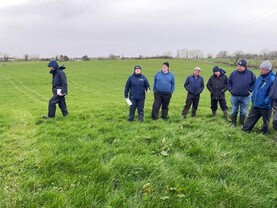With all the cows housed at this stage, Shaun Diver has gone through each batch and pulled out any cow that needs a bit of extra feeding over the next six weeks or so.
Thankfully, due to the good weather and decent levels of grass growth throughout autumn, the number of cows that are below target body condition is very small.
However, correcting this now, rather than in the last few weeks prior to calving, should be the priority on all suckler farms.
Shaun said: “Overall, cow condition is very good this year and has improved further since weaning a few weeks ago. The few we have pulled out for a bit more feeding are either younger cows or first-cross dairy types that tend to be a bit leaner.”
Assessing condition
Body condition score (BCS) is an assessment of condition on the animal at three sites – the ribs, the loin and the tail head and is scored on a five-point scale, where BCS 1 is a really thin cow and BCS 5 is an extremely fat cow. Typically cows on farm will fluctuate between a BCS of 2 and 3.5.
The target for spring-calving herds is for cows to calve down at a BCS of 2.5. In an ideal world, all cows would come into the winter period in a condition score of 3 to 3.5.
In this way, they can afford to lose some condition over the winter period in the run-up to calving. This reduces feed costs during the expensive winter period.
Any condition loss should be done slowly and steadily over the first three months of winter. In the last month to six weeks pre-calving, cows should not be losing or gaining much condition at all.
This is why it is important to sort and pen cows correctly now, and start to feed to body condition.
Managing condition
While it is easy to pick out a thin cow from the herd and separate them for additional feeding, it is important to be able to distinguish subtle changes in body condition score over a period of time.
Keep an eye on cow condition throughout the winter and be prepared to alter diets where needed if cows are gaining or losing condition too quickly.
Silage quality
On Tullamore Farm, Shaun is confident that the first-cut silage, with a DMD of 71.5%, is good enough to bring up BCS of the thinner cows between now and the run-up to calving.
Where this higher-quality silage is not available on farm, concentrates will need to be fed in order to improve condition.
The second-cut silage has a DMD of 67% and while it is sufficient for the cows that are on or above target BCS, there simply is not enough energy in it for cows to increase BCS on this feed.
“There are a handful of cows in really good BCS, maybe as high as 4. I will be keeping a watchful eye on these cows, because too much condition is as bad as being too thin at calving time.
"More conditioned cows will experience more calving difficulties, as they will have more fat reserves in around the pelvis. Combined with this, calves can get overly big if nutrition in late pregnancy is not correct.”
On Thursday 25 November at 8pm, the Irish Farmers Journal, in association with AXA Insurance, will host a winter cattle series webinar on nutrition.
Tune in at www.farmersjournal.ie/webinar to hear more from Tullamore Farm on the winter diets and production targets for the coming months.






 This is a subscriber-only article
This is a subscriber-only article










SHARING OPTIONS: